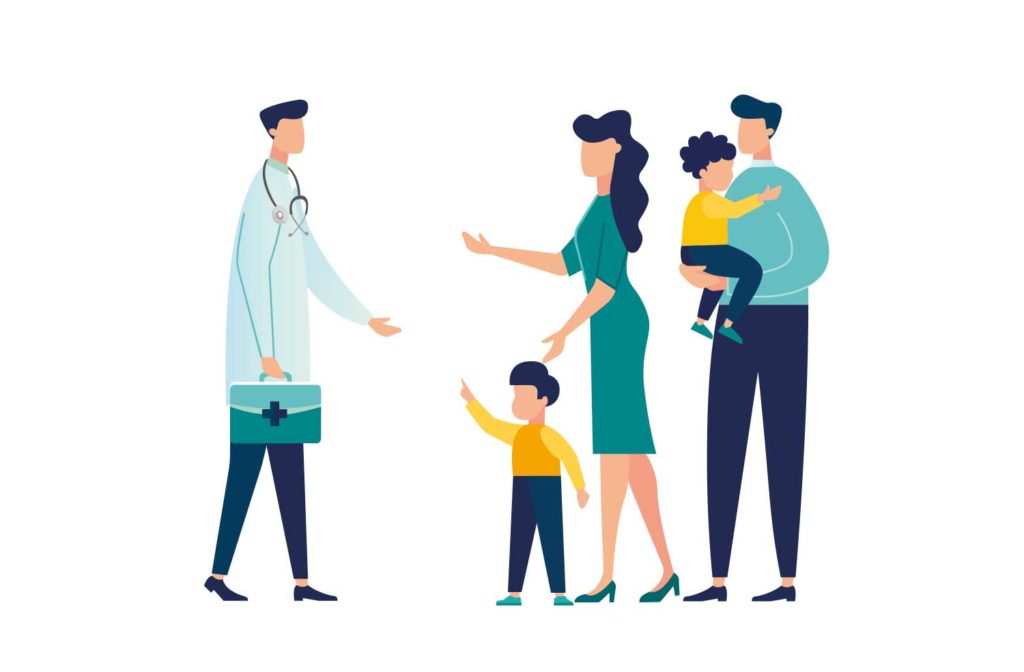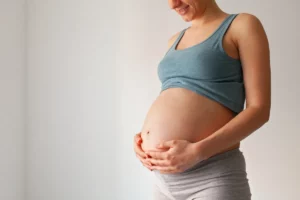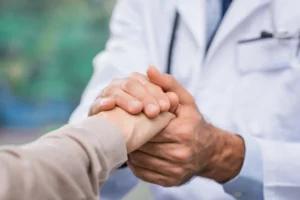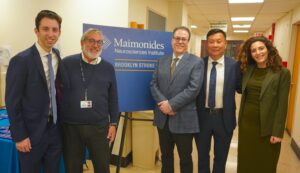Summary
The day your kid is diagnosed with cancer is a terrifying one. Join us as we talk to Dr. Jeffrey Avner, Dr. Ludovico Guarini, and Dr. Mahmut Celiker about their whole-child, whole family approach towards pediatric cancer patients and why being a member of the Children’s Oncology Group (COG) puts Maimonides Children’s Head way ahead of the rest.
Listen on Spotify Listen on Apple Podcasts Listen on Google Podcasts
Transcript
Caitlin Whyte: The Children’s Oncology Group or COG is a National Cancer Institute-supported clinical trials group. And it’s the world’s largest organization devoted exclusively to childhood and adolescent cancer research. Maimonides has been a member of the COG since March 2019, and it’s the only COG-participating hospital in Brooklyn.
Joining us to tell us some more about this distinction and what it means to our community are three of our doctors, Dr. Ludovico Guarini, the Chief of Pediatric Hematology and Oncology; Dr. Jeffrey Avner, the Chair of Pediatrics; and Dr. Mahmut Celiker, Principal Investigator of the Maimonides Children’s Oncology Group.
This is Maimo Med Talk. I’m your host, Caitlin Whyte. So Dr. Avner, to start us off, let’s talk about the space itself. What does the pediatric facility offer?
Jeffrey Avner, MD: It really offers a dedicated, specialized, not only physical plant in which we can treat children, but it also gives specific interdisciplinary services that are aligned with children.
So just as an overview, I think it’s important to remember that when you have a child with cancer, the impact is felt by the entire family. The diagnosis of these children usually comes when a family is young and may have limited resources. And sometimes there are other small children to care for and a parent may have to stop work to care for the sick child or take many days off.
And then on top of it, and I think this is very important to differentiate children from adults is that children usually do not have the cognitive knowledge or understanding of what having cancer means or why they need to spend so much time in the hospital and take so many medications. So our pediatric cancer care center really provides an interdisciplinary approach among the doctors, nurse practitioners, nurses, pharmacists, technicians, aides, social workers, child life specialists, and many other staff.
And since March 2019, we became the only hospital in Brooklyn that is a member of the National Children’s Oncology Group. So that now Maimonides can provide the full range of treatment option to our families right here in Brooklyn, and really help them understand that they’re not alone in this fight.
Caitlin Whyte: Well, that leads me into my next question. Why is it so important to have this right in Brooklyn?
Jeffrey Avner, MD: Again, I think it’s important to have the ability to treat cancer locally, if possible. Because it does involve multiple trips to the oncologist, to the pediatric cancer center, to potentially other pediatric medical specialties. And that requires a lot of time and effort.
And often, pediatricians are local and they become an important part of the interdisciplinary approach that we have. It’s not just the oncologist and the medical specialist, but their regular pediatricians as well. And so as much as we can keep that in a local area or region, I think it really makes it a lot easier for the families to deal with a very difficult problem.
Caitlin Whyte: Now, Dr. Celiker, can you tell us a bit about childhood cancer rates? How have we made progress in this area?
Mahmut Celiker, MD: Approximately 15,000 children and young adults, adolescents are diagnosed with one type of cancer throughout their life in the United States. And that hasn’t actually changed a lot, except brain tumors have increased slightly over the last 20, 30 years.
And the cure rates are reaching 90% these days. And one of the reasons we have this high cure rates is because we are able to study the cancer and we are able to study how to treat it the best way possible through collaborative research. And the Children’s Oncology Group is the main collaborative center for these kinds of studies.
Caitlin Whyte: Now having this facility right in Brooklyn, you know, you get so much access to all parts of New York City, why is diversity so important when it comes to clinical trials?
Mahmut Celiker, MD: In most of the adults clinical trials, the diversity is underrepresented. And that’s primarily because under the minority group, there is a certain level of mistrust to the health system and there is a certain level of inadequate access to the health system. So minorities are underrepresented in those clinical trials. So when the clinical trials are completed with outcomes, it’s not always generalizable. And that’s the goal is to be able to offer it to everybody. Brooklyn is the center of diversity and it’s an excellent center to be able to enroll different minorities of different backgrounds to the clinical trials to help address your gap.
Caitlin Whyte: A big part of this conversation is the Children’s Oncology Group or COG. So tell us more about that and how being a part of it affects the type of cancer care we provide.
Mahmut Celiker, MD: Children’s Oncology Group is a group that studies to better understand the cancer in children, why it happens and what are the factors that contribute to the outcomes and how we can prevent it. It actually has two major main components.
The first one is understanding the biology of the tumor. So we try to collect as much tumor samples as possible and send it to the research laboratories around the country and around the world that is part of the Children’s Oncology Group who can study molecular specifics of those cancers and understand better. And this is called the tumor registry system and participation doesn’t actually give any premise of any benefit to the patients. And fortunately, we were lucky enough with enrollment, a hundred percent of the patients that we approached all agreed to participate in this process, knowing that they will not get any direct benefits, but they want to contribute to the general knowledge in childhood cancer.
And the second component is the clinical trials. And the clinical trials are designed to help improve outcome. So we already have an established system, established treatment modalities available currently for cancers in childhood, and we call it the gold standard treatment. And there are many intelligent people who come up with ideas, new treatment modalities, new therapeutic options become available, we need to be able to determine if those options improve the outcome by either decreasing the chemotherapy or increasing the survival for children. These are done in the form of clinical trials and clinical trials is trying to understand whether a new treatment or a different treatment is better than what you are currently practicing. And about 80% of the patients that we approached where we had a clinical trial, they also agreed to participate in helping to improve the outcomes for the entire pediatric cancer population. But also, they also have hopes that they will benefit from that.
Caitlin Whyte: And Dr. Guarini, let’s talk about the actual people, the patients in these trials. What are some advantages for the patients who choose to participate in them?
Ludovico Guarini, MD: So there are two main advantages. One is that often these trials will give access to medications that are at the cutting edge. And so they’re not yet approved for a specific form of cancer. But because they are studied in that particular cancer by COG, they could become available to particular patients.
The other aspect that is also very important enough and not recognized enough is the fact that these studies, because our investigational studies are monitored very closely, so the understanding that perhaps one treatment is better than another, or the recognition of some side effect that was recognized prior on the study, filtered down to the patients very rapidly, much more rapidly that will happen if you use standard care because again, the monitoring and the many people that are involved in the studies, so those are two of the major advantages.
And then for those patients who are randomized for one treatment versus another, there is the fact that they may find a direct advantage because, for instance, the newer arm of the protocol, the one that is generally considered the experimental arm may indeed offer an advantage, but until you know for a fact you don’t know, but yet if you participate in this study, you may be in that situation.
So those are some of the advantages that exists. And also the fact that you’re assured that the treatment that a particular child receives is actually a treatment that is accepted by the wide community of physicians. Probably in this country and some other countries, COG actually has some affiliates abroad as well that are highly specialized in the management of children with cancer.
Caitlin Whyte: And wrapping up here, you know, we spoke a lot about the importance of having this center right in Brooklyn. What are some of the community societal benefits of pediatric cancer clinical trials?
Mahmut Celiker, MD: So think about the fact that Brooklyn is a town of almost 3 million people and with actually a very complex structure from, you know, viability, moving around, traffic, public transportation. And thinking about the fact that in order to get to other locations within this pretty large metropolis we live in, it may be very, very difficult. And in addition to that, now we have the challenges that, for instance, COVID has brought forth. So the ability to having community like Brooklyn a center that is able to manage this very highly complicated patients with state-of-the-art therapy, because being in COG means that you’re really use the cutting edge for pediatric cancer therapy in the United States and in the world, it allows people who live here in Brooklyn, not to have to go to other boroughs or other places in order to get their treatment.
And going back to something that Dr. Avner was mentioning, I mean, pediatric patients with cancer really affects very large number of people within the family, within the community. And the fact that you’re closest to home, that there is an ability for us to do things without having to spend three hours commuting back and forth to where you need to go. Given the fact that a lot of the times, the kids spends a lot of time either with us in the clinic or in the inpatients, the ability to have the fact that siblings may have an opportunity you to see the sibling that is in the hospital, just because they’re closer. All of this things represent an incredible benefit for this children that unfortunately has to deal with such a difficult disorder and for their families.
Jeffrey Avner, MD: It really takes a village to care for an ill child and especially a child with cancer, because it involves again a wide array of potential medical problems that are associated with primary cancer. And again, it’s not just the medical needs that need to be met, but it’s their psychological needs of the child and the psychological needs of the families and the siblings Dr. Guarini has mentioned as well.
And so it is very important, not only to have the state-of-the-art medical care, but also to have the additional support structures such as social work, child life, patient liaisons, et cetera, who are experienced in dealing with children with cancer, because that can really make a difference in how not only the children feel about having cancer, but the ability of the entire family to deal with having a child with cancer.
Caitlin Whyte: Great. Well, doctors, just some incredible resources right here in the neighborhood. Is there anything else that we didn’t touch on that you want to add?
Ludovico Guarini, MD: Well, I think that one thing that is relevant for the public at large to understand is that when I started in this business, which was a few decades ago, the cure rate for one of the most common cancers in the pediatric population, which is acute lymphoblastic anemia, was somewhere in the neighbor of perhaps60% cure, which actually was remarkable already at that time. But nowadays, we’re talking about cure rates for acute lymphoblastic leukemia that vary between 85 or 95%, depending on the subtypes. And all of this has been achieved through the contribution that this Children’s Oncology Group has done.
So at one end, you have the benefit for the individual, but then the contribution of all the kids that have participated in studies and it’s thousands of them over the decades, actually hundreds of thousands at this point, has essentially brought the state-of-the-art, the understanding and the ability to provide and the promise for a cure for this children and their families to that aspect. So it’s important for the individual, but it’s also important for the society and these patients get a benefit and provide an incredible contribution to the understanding and the progress that is made.
Caitlin Whyte: Well, doctors, we appreciate you being here so much with your busy schedules to tell us more about what’s going on right here at our neighborhood. You can find more about us online at maimo.org. That’s M-A-I-M-O dot org. This has been my Maimo Med Talk. I’m your host, Caitlin Whyte. Stay well.







